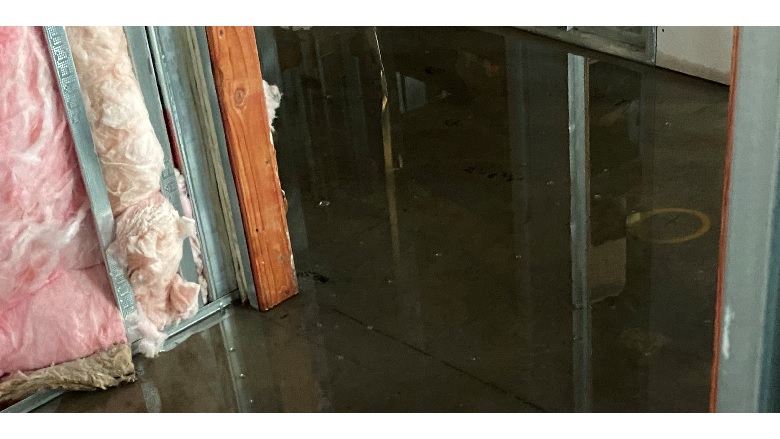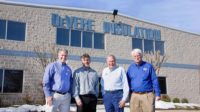A River Runs Through It: Wet Job Sites
Documenting and controlling interior job site conditions

Contractors working in the Pacific Northwest are well-accustomed to the persistent light rain, cool temperatures and gray skies that return every year at the end of the beautiful summer. The annual return of a weather pattern known as the Pineapple Express, originating in the Hawaiian Islands, moves eastward and makes landfall anywhere along the west coast, delivering high winds and heavy rainstorms. Meteorologists refer to this scale of water vapor movement as atmospheric rivers, air currents that transport tremendous volumes of water vapor that results in rain or snow. In the fall of 2021, cities in British Columbia and the state of Washington were hit especially hard by multiple Pineapple Express storms. The storms produced high winds and tremendous volumes of wind-driven rain. Residents in some cities had to be evacuated due to flooding, mud slides and washed-out roadways. Construction job sites were not immune to the siege.
Gypsum wallboard contractors with projects in progress are often confronted by cold, wet and, in some cases, flooded job sites. GWB contractors are well aware of the impact cold and wet conditions have on perfectly finished wallboard. The appearance of joint ridging, screw depressions aka delayed shrinkage, starved joints and joint cracking are the symptoms of the environmental job site conditions not being in compliance with the provisions of ASTM C840, the IBC or manufacturers recommendations.
ASTM C840 - Environmental Conditions
“4.1 Application of Gypsum Board, Joint Treatment Materials, and Adhesives—Room temperature shall be maintained at not less than 40 °F (4 °C) during application of gypsum board except when adhesive is used for the attachment of gypsum board. For the bonding of adhesive, joint treatment, texturing and decoration, the room temperature shall be maintained at not less than 50 °F (10 °C) for 48 h prior to application and continuously thereafter until completely dry. See X7.7 for additional details regarding environmental control during the installation and finishing process.”
Since at least 2006, the International Building code Chapter 25, Section 2508 has required the following:
2508.2.1 Weather protection
“Gypsum wallboard, gypsum lath or gypsum plaster shall not be installed until weather protection for the installation is provided.”
An industry guidance document by United States Gypsum Corp. titled Evaluating Jobsite Environmental Conditions discusses interior job site environmental conditions that contribute to thermal and hygrometric movement of GWB. USG recommends that an interior temperature of 55 degrees Fahrenheit should be maintained during the entire finishing process and until the joint compound is completely dry. USG also recommends that no joint compounds or coatings should be applied unless the surface temperature of the GWB is at least 5 degrees Fahrenheit above dew point and that surface temperatures must be maintained above dew point throughout the curing process.
 The Northwest Wall and Ceiling Bureau team routinely responds to contractors’ concerns over interior environmental conditions with site visits to access current job site conditions and the potential impacts on the projects. The NWCB site visits focus on documenting the following conditions:
The Northwest Wall and Ceiling Bureau team routinely responds to contractors’ concerns over interior environmental conditions with site visits to access current job site conditions and the potential impacts on the projects. The NWCB site visits focus on documenting the following conditions:
- The extent of permanent or temporary weather tight enclosures installed to protect and separate the work areas from exterior conditions and moisture accumulation. This is a requirement of the IBC, as noted above.
-
Interior and exterior environmental conditions.
- Air temperature, relative humidity, dew point calculations and GWB surface temperature measurements.
- The extent of the presence and deployment of mechanical equipment to heat, dehumidify or ventilate the interior workspace.
- GWB moisture content readings compared to a control sample of dry GWB. Measurements are presented in a wood moisture equivalent reading as is customary on construction sites.
- Conditions and damage to finished GWB surfaces consistent with interior environmental conditions outside of industry recommendations.
- The source and movement of bulk water if present.
Additionally, the inspection team members will request and review:
- The GWB contractor’s daily reports in order to incorporate the history of those findings into our report. Contractors need to measure and document work site environmental conditions on a daily basis. The deployment and use of the new and relatively inexpensive data-logging thermo-hygrometers is highly recommended. They will record data on projects from start to finish, including weekends.
-
Project specifications or the environmental control plans, if available.

Surfactant Leeching
In the course of inspecting one hard-hit job site this fall, we observed streaking on finished surfaces that had received an initial coat of primer.
On top of the base trim, we observed an oily residue along with visible screw depressions. The residue is a paint condition known as “surfactant leeching,” which was observed on finished and painted surfaces in several locations. Surfactant leeching is understood to be the result of freshly painted surfaces being exposed to low temperatures, bulk water and/or excessively high relative humidity. The appearance of an oily, sap-like substance is an indication of the condition.
GWB surfaces were measured below the dew point temperature. Condensation was observed on finished GWB surfaces.
- Interior air temperature was measured at 54 degrees Fahrenheit.
- Interior relative humidity was measured at 94%.
- The dew point was calculated to be at 52 degrees Fahrenheit.
- The gypsum board surface was measured at 51 degrees Fahrenheit.
The USG recommendation that the surface temperature of the GWB be maintained above dew point throughout the curing process was not followed.
Other common findings and observations from wet job site inspections include:
- Temporary enclosures protecting work areas and finished work from weather, water and moisture accumulation were not uniformly in place.
- Standing water was routinely observed.
- Interior conditions were not being maintained at a uniform and continuous temperature above 55 degrees Fahrenheit for 48 hours prior to and following the application of GWB and joint treatment materials.
- Temporary heating, humidity control and ventilation in work areas were not present. In some instances, they were present but not active.
- Wallboard moisture content measurements were well above the dry control sample measurement of 9% WME.
- GWB surface temperatures were below dew point temperatures.
- Condensation observed on the surfaces of finished and painted GWB.
- Screw depressions and joint ridging were observed.
In many locations throughout the country, exterior conditions will be well outside of the industry recommendations for finishing activities. General and GWB finishing contractors need to have written environmental control plans in place and enforced on job sites to maintain the interior conditions industry recommendations for finishing activities and, ultimately, to deliver high-quality finished walls and ceilings.
Construction Site Interior Environmental Control Plans
Formal job site environmental control plans are starting to be used by project teams, and the examples we have seen often describe the plan as a tool “to identify and manage potential environmental impacts to the construction materials and interior finishes during construction.”
The ECP clearly lay out job-specific requirements, sequencing and responsibilities in order to create and maintain environmental conditions necessary to ensure compliance with industry standards and to deliver a high-quality finished product. Providing either the final, finished or a temporary enclosure that will provide separation from low or elevated temperatures, humidity, rain and wind is the key to being able to control the interior conditions. You will not be able to control heat, humidity or prevent entry of wind-blown rain without an enclosure. Examples of provisions included in an ECP are to:
- Supply and install temporary enclosures of reinforced, storm-rated 10 millimeter polyethylene on all sides of the building at window and building openings of active work areas.
- Supply and deploy temporary heaters, dehumidifiers and circulation fans sufficient to create and maintain conditions that promote joint compound drying within 18-24 hours.
- Deploy data logging thermo-hygrometers, one per every 10,000 square feet of interior space with at least one per floor. This data will provide 24/7 information on the effectiveness of the plan for the duration of the project.
The GWB finishing preconstruction meeting is the opportunity for contractors to discuss the plan or to propose a plan if there is not one. Without a formal plan or even a discussion, the proper interior environmental conditions required for finishing GWB are often delayed until after the Pineapple Express makes another undesired delivery.
This article first ran in the NWCB’s Winter/Spring 2022 Newsletter.
Looking for a reprint of this article?
From high-res PDFs to custom plaques, order your copy today!










